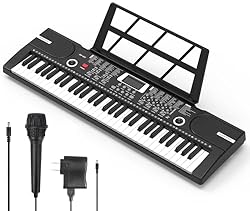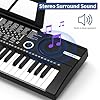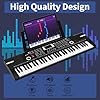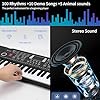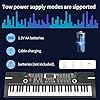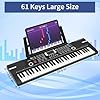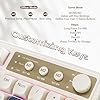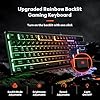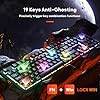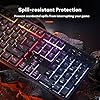Table of Contents
Learning Piano with Minimal Equipment: A Beginner’s Guide
Embarking on the journey of learning the piano can seem daunting, especially when faced with constraints like limited access to traditional instruments or expensive equipment. However, with the right approach and innovation, beginning piano lessons need not require hefty investments. This guide explores how you can harness the potential of minimal equipment to kickstart your musical journey, ensuring an effective and enriching learning experience that makes the most of modern resources and creative methods.
Choosing the Right Keyboard for Learning Piano
When starting your piano learning journey, the right equipment is essential. A keyboard is a great choice for beginners due to its affordability and convenience. Here are some key considerations when selecting a keyboard for learning piano:
Yamaha Arius Series 88-Key Weighted Action Upright Digital Piano, CFX Concert Grand Piano Voice, 3-Pedal Unit, Bench Included, Classic Upright Design, Black YDP145B
17% OffFree Piano - Learn to Play Piano
$0.00 (as of November 22, 2025 22:56 GMT -08:00 - More infoProduct prices and availability are accurate as of the date/time indicated and are subject to change. Any price and availability information displayed on [relevant Amazon Site(s), as applicable] at the time of purchase will apply to the purchase of this product.)Classical Piano for Sleep and Relaxation
$9.99 (as of November 22, 2025 22:56 GMT -08:00 - More infoProduct prices and availability are accurate as of the date/time indicated and are subject to change. Any price and availability information displayed on [relevant Amazon Site(s), as applicable] at the time of purchase will apply to the purchase of this product.)61 keys keyboard piano, Electronic Digital Piano with Built-In Speaker Microphone, Sheet Stand and Power Supply, Portable piano Keyboard Gift Teaching for Beginners
$164.00 (as of November 22, 2025 23:10 GMT -08:00 - More infoProduct prices and availability are accurate as of the date/time indicated and are subject to change. Any price and availability information displayed on [relevant Amazon Site(s), as applicable] at the time of purchase will apply to the purchase of this product.)The ideal keyboard for beginners should have at least 61 keys, but full-size keyboards with 88 keys are preferable as they replicate the range of a traditional acoustic piano. This allows for a more comprehensive learning experience as you advance.
Choosing a keyboard with weighted keys offers a feel closer to that of an acoustic piano. This is crucial for building the proper finger strength and technique. Look for terms like “hammer action” or “graded hammer action” which indicate a higher quality of key weighting.
A touch-sensitive keyboard means that the volume of the sound changes according to how hard you press the keys. This feature is vital for developing expressive playing skills. Most modern keyboards include this feature, but it’s wise to confirm before purchasing.
The sound quality of a keyboard can vastly influence the learning experience. Opt for a keyboard with high-quality, realistic piano sounds. This usually means a higher polyphony number (the number of sounds a keyboard can produce at once), which should be at least 64-note polyphony.
Yamaha Arius Series 88-Key Weighted Action Digital Piano for Aspiring Musicians, CFX Concert Grand Piano Voice, 3-Pedal Unit, Bench Included, Classic Upright Design, Dark Rosewood YDP145R
17% OffYamaha Arius Series 88-Key Weighted Action Upright Digital Piano, CFX Concert Grand Piano Voice, 3-Pedal Unit, Bench Included, Classic Upright Design, Black YDP145B
17% OffDonner Digital Piano Keyboard Velocity-Sensitive 88 Keys with Removable Piano Stand, Compact Beginner Home Electric Piano with Split Mode, LED Digital Tube for Display, and Triple Pedal DEP-08
$279.99 (as of November 22, 2025 08:02 GMT -08:00 - More infoProduct prices and availability are accurate as of the date/time indicated and are subject to change. Any price and availability information displayed on [relevant Amazon Site(s), as applicable] at the time of purchase will apply to the purchase of this product.)Donner DEP-1S Piano Keyboard 88 Keys, Beginner Digital Piano with 88 Key Velocity-Sensitive Keyboard, Record, Bluetooth, Chord, Bundle With Piano Stand, Piano Stickers, Sustain Pedal, Retro Wood Color
$219.99 (as of November 22, 2025 08:02 GMT -08:00 - More infoProduct prices and availability are accurate as of the date/time indicated and are subject to change. Any price and availability information displayed on [relevant Amazon Site(s), as applicable] at the time of purchase will apply to the purchase of this product.)Additional features like built-in metronomes, chord dictionaries, and USB connectivity for MIDI support can greatly enhance practice sessions. Although not essential, these features can be very helpful for beginners.
If you plan on transporting your keyboard, consider its weight and durability. Lightweight keyboards are ideal for musicians who travel frequently. Ensure the keyboard is sturdy enough to withstand regular movement.
Set a realistic budget when shopping for a keyboard. While more expensive models come with advanced features, many affordable keyboards are perfectly suitable for beginners. Balance cost with the features you need to ensure a worthwhile investment.
Choosing the right keyboard is a crucial step in your piano learning journey. By considering these factors, you can select a keyboard that not only meets your current needs but also supports your future growth as a pianist.
Setting Up Your Practice Space on a Budget
Creating an effective practice space doesn’t have to be expensive. Here are some practical tips to help you set up your piano practice area without breaking the bank:
While a traditional acoustic piano might be ideal, it’s not always feasible due to cost and space. Opt for an affordable digital keyboard. Look for a model that has weighted keys to simulate the feel of an acoustic piano. Brands like Casio, Yamaha, and Roland offer budget-friendly options that provide excellent quality for beginners.
A sturdy stand and a comfortable bench are essential for proper posture and technique. Instead of purchasing new, check second-hand stores, online marketplaces, or community groups for used equipment. Sometimes, you’ll find quality items for a fraction of their original price.
Take advantage of the plethora of free online resources. Websites like YouTube have countless tutorials that can guide you through the basics. Additionally, consider inexpensive apps designed for piano learners. Apps such as Yousician and Simply Piano often offer free trials or budget-friendly subscription plans.
Ensure your practice space is quiet and free from distractions. Clear a corner of a room where you can set up your keyboard, stand, and bench comfortably. Use a solid flat surface for your keyboard if an actual stand is beyond your budget initially. A foldable table or desk can sometimes suffice.
Good lighting is crucial when reading sheet music or watching tutorial videos. Utilize lamps you already own and arrange them around your practice space to avoid shadows. Inexpensive clip-on LED lights can also be a great solution and are usually available at low cost.
Practicing with headphones can be immensely beneficial, especially if you live with others or in an apartment building. Headphones allow you to practice without disturbing others and help you focus on your playing. Many digital keyboards come with a headphone jack, and a decent pair of headphones can be found at a reasonable price.
If your keyboard doesn’t come with a music stand, consider DIY solutions or find one second-hand. Look for inexpensive bookstands or create a makeshift stand using a sturdy cardboard box. The goal is to prop up your sheet music at a comfortable eye level.
Make your practice area inviting. Add personal touches like posters of your favorite musicians or a small plant. This encourages a positive and motivating environment, without any significant added cost.
By being resourceful and prioritizing essential equipment, setting up a conducive practice space on a budget is entirely achievable. Happy playing!
How to Practice Effectively Without a Full Piano
Using Mobile Apps
Beginners can leverage mobile apps designed for learning the piano. These apps often provide interactive lessons, exercises, and sometimes games to keep learners engaged. Many apps use real-time feedback features to correct users’ play in real-time, which can rapidly accelerate learning curves. Popular apps like Simply Piano or Flowkey offer courses that are structured from basic to advance, obviating the need for traditional sheet music.
Digital Music Software
Digital music software, or DAWs (Digital Audio Workstations), like GarageBand or Logic Pro, can be potent alternatives to traditional sheet music. Such platforms often feature virtual instruments, samples, and comprehensive tutorials that teach music theory and practice simultaneously. Beginners can use these tools to compose, edit, and visualize music patterns without needing to read standard notation right off the bat.
Video Tutorials
Platforms like YouTube have a plethora of video tutorials available ranging from free user-generated content to more structured subscription-based classes from professional musicians. These tutorials are great for beginners as they demonstrate practical play and can be paused and replayed, catering to self-paced learning. Seeing a song being played can sometimes be more beneficial than trying to decode sheet music for novices.
Light-Up Keyboards
A technology-oriented approach involves using light-up keyboards, which help beginners learn by lighting up the correct keys during a song. Systems like The ONE Smart Piano integrate with apps, lighting up notes in sync with accompanying music. This method, providing direct visual cues, simplifies learning and helps in building muscle memory without initially focusing on reading music.
Ear Training and Play by Ear Guides
Ear training tools and resources enable learners to recognize musical intervals, chords, and rhythms by ear, which can be an effective way to understand and play music without sheet music. This approach trains beginners to play songs by ear by listening to them repeatedly and trying to replicate the tunes on the piano, cultivating an intuitive understanding of the piano keys and their sounds.
Making the Most of Free Online Piano Resources
Exploring Online Tutorials and Lessons
Taking advantage of the myriad of free online piano tutorials is a fantastic way to begin. Platforms like YouTube have countless instructional videos for every skill level. Focus on finding a series or an instructor who caters to absolute beginners. For structured learning, seek out playlists that progress gradually, covering basic chords, scales, and eventually move on to more complicated pieces.
Utilizing Piano Learning Apps
Many applications offer tiered learning models; starting from free versions, they are perfect for beginners. Apps like Simply Piano or Yousician provide interactive lessons that offer real-time feedback, a crucial feature for self-learners. Although the full versions are paid, their free content is rich enough to get novices moving with essential piano skills.
Downloading Piano eBooks and Sheets
Many websites offer free piano sheet music which ranges from classical compositions to contemporary pop songs. Websites like 8notes or Musescore not only provide free sheets but also tools to help learners understand music notation. Moreover, look for free eBooks that are often available through digital libraries or specific educational websites; these can serve as great theoretical supplements.
Participating in Online Forums and Social Media Groups
Join forums and social media groups focused on piano learning. These platforms allow you to ask questions, share your progress, and get tips from more experienced pianists. Reddit’s r/piano or Facebook piano groups are vibrant communities where you can find motivation, various resources, and support from fellow learners.
Follow Online Masterclasses and Live Sessions
Look for online masterclasses and workshops, many of which are available at no cost on platforms like MasterClass or Twitch. These sessions are often hosted by professional musicians and can provide insights into technique and creativity that pre-recorded lessons might not offer.
Conclusion
Embarking on your piano learning journey with minimal equipment is entirely feasible and can be incredibly rewarding. By focusing on essential tools like a basic keyboard, sheet music, and reliable learning resources, you can make significant progress without a large investment. Remember, the key to success is consistency, practice, and a passion for music. With these elements, you’ll be well on your way to mastering the piano. Keep practicing, stay motivated, and enjoy the wonderful world of music!















